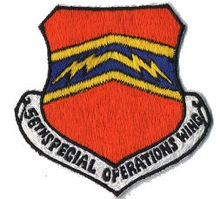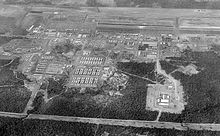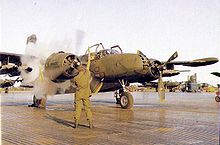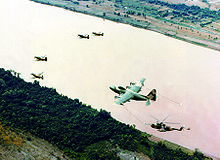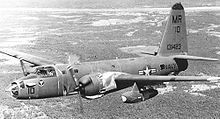- Nakhon Phanom Royal Thai Navy Base
-
Nakhon Phanom Royal Thai Navy Base Part of Royal Thai Navy (RTN) Type Naval Air Base Coordinates 17°23′02″N 104°38′35″E / 17.38389°N 104.64306°E Current
conditionMilitary Naval Air Base Battles/wars 
Vietnam WarAirfield information IATA: none – ICAO: none Summary Elevation AMSL 587 ft / 179 m Runways Direction Length Surface ft m 15/33 8,203 2,500 Asphalt For the civilian use of the facility, see Nakhon Phanom Airport.Nakhon Phanom Royal Thai Navy Base (NKP), formerly Nakhon Phanom Royal Thai Air Force Base, is a Royal Thai Navy facility used for riverine patrols along the Mekong River. It is located approximately 365 miles (584 kilometers) northeast of Bangkok, 9 miles west of Nakhon Phanom city in Nakhon Phanom Province in the Northeastern Region of Thailand, and 75 miles from Hanoi Vietnam. The Mekong River makes up NKP's border against Laos. The airfield at NKP is jointly used as a civilian airport.
Contents
- 1 History
- 2 History of the USAF at NKP
- 3 Accidents and incidents
- 4 See also
- 5 References
- 6 Other sources
- 7 External links
History
Nakhon Phanom Royal Thai Navy Base was established in the 1950s as a RTAF base. Political considerations with regards to Communist forces engaging in a civil war inside Laos and fears of the civil war spreading into Thailand led the Thai government to allow the United States to covertly use five Thai bases beginning in 1961 for the air defense of Thailand and to fly reconnaissance flights over Laos.
Under Thailand's "gentleman's agreement" with the United States, Royal Thai Air Force Bases used by the USAF were considered Royal Thai Air Force bases and were commanded by Thai officers. Thai air police controlled access to the bases, along with USAF Security Police, who assisted them in base defense using sentry dogs, observation towers, and machine gun bunkers. All United States Air Force personnel were fully armed after 1965.
The USAF forces at Nakhon Phanom were under the command of the United States Pacific Air Forces (PACAF).
The APO for NKP was APO San Francisco, 96310
History of the USAF at NKP
For more details on this topic, see Laotian Civil War.During the Vietnam War Nakhon Phanom Royal Thai Air Force Base (NKP) was a front-line facility of the Royal Thai Air Force used by the United States in its efforts to defend South Vietnam against insurgency by North Vietnam and the Pathet Lao Communist guerillas in Laos from 1961 to 1975.
Beginning in the late 1950s, North Vietnam began to move troops into areas of eastern Laos in support of the Pathet Lao, and also as a defensive measure to protect their long transit route for men and supplies to support the insurgency in South Vietnam. In September 1959, North Vietnam formed Group 959 in Laos with the aim of building the Pathet Lao into a stronger force in its guerilla war aimed at overthrowing the Royal Lao Government. Group 959 openly supplied, trained and supported the Pathet Lao militarily.
With Thailand sharing a long common border with Laos along the Mekong River, the Thai government was increasingly concerned about the spread of a communist insurgency into Thailand, which already faced a growing insurgency of its own in that part of the country.[1] It was therefore receptive to the idea of allowing U.S. military personnel to use Thai territory for operations in support of the Lao Government, and later in support of the Republic of Vietnam.
The first American military personnel to arrive at NKP in 1962 were the U.S. Navy's Mobile Construction Battalion Three (Seabees) who undertook the task of constructing runways and raising the first buildings at the new base as part of a United States commitment under SEATO.[2] Detachment 3 (Provisional) of the Pacific Air Rescue Center with three HH-43B helicopters became the first USAF unit assigned to the base in June 1964. Followed by the [507th Tactical Control Squadron] who began arriving in August 1964, with the bulk of its personnel arriving in 1964. The 5th Tactical Control Group exercised command jurisdiction over the 507th until May 1965 when the 6235th Air Base Squadron was formed. Overall control of the USAF units was then turned over to the 35th Tactical Group (now the 631st Combat Support Group) at Don Muang Airport, Thailand. On 8 April 1966 the 6235th Air Base Squadron was discontinued and the 634th Combat Support Group along with its subordinate squadrons was activated.[3] With U.S. irregular warfare operations already being conducted from the base, on 2 February 1966, the Thai government approved the establishment of a United States Air Force Air Commando unit in Thailand, using the existing USAF facilities at NKP to give the appearance that the United States was not introducing another unit into Thailand. USAF forces at NKP were under the overall command of the United States Pacific Air Forces (PACAF).
NKP initially housed USAF search and rescue forces and maintained a communications capability in support of U.S. Air Force objectives in Southeast Asia. NKP was the location of TACAN station "Channel 89" and was referenced by that identifier in voice communications during air missions. The 634th Combat Support Group was deactivated and the 56th Air Commando Wing was formed on 8 April 1967. The [606th Air Commando Squadron] formed the operational backbone of the new wing, and the 56th Combat Support Group took over the major support functions. Nearly one year later the 56th ACW designation was changed to 56th Special Operations Wing, 1 August 1968.[3]
There were a number of special operational squadrons attached to the wing over time, including the 1st, 18th, 21st, 22nd, 602nd, 606th and 609th, and a number of other operational squadrons and detachments, including the 23rd Tactical Air Support Squadron and the 554th Reconnaissance Squadron. The major operational associate units stationed at NKP were the 1987th Communications Squadron (AFCS), Det 5, 621st Tactical Control Squadron, elements of the 40th Aerospace Rescue and Recovery Squadron and Task Force Alpha (PACAF). Along with USAF Air Commando and Special Operations forces, MACV-SOG units operated out of NKP, along with Air America, Echo 31 and other clandestine organizations which used NKP as an operating base for their activities in Laos, Cambodia and North Vietnam.
The APO for NKP was APO San Francisco, 96310
56th Special Operations Wing
The lineage of the 56th Special Operations Wing goes back to the 56th Fighter Wing which was created in 1947. Redesignated the 56th Air Commando Wing, and activated on 16 March 1967, the Wing was redesignated the 56th Special Operations Wing on 1 August 1968. The USAF facility at NKP was the only one in Southeast Asia which operated entirely under the control of an Air Commando/Special Operations Wing. The official mission of the 56th was to assist United States unconventional forces and foreign government military forces friendly to the United States in various parts of Indochina.
There were no tactical fighters or bombers at NKP, only older propeller driven aircraft and specialized aircraft, some dating back to the World War II era. Some of the aircraft operating out of NKP bore civilian markings or were unmarked. In addition, the 56h SOW also worked closely with the U.S. embassies in Laos and Thailand to provide training for special air warfare units.
Squadrons of the 56th SOW
Special Operations Squadrons
- 1st Air Commando Squadron (redesignated 1st Special Operations Squadron August 1, 1968), 20 December 1967 - 15 December 1972, call sign "Hobo":(A-1E/G/H/J, Tail Code: TC)
- 18th Special Operations Squadron 25 August 1971 - 31 December 1972, call sign "Stinger":(AC–119, Tail Code: EH)
- 21st Helicopter Squadron (redesignated 21st Special Operations Squadron) August 1, 1968), 27 November 1967 - 30 June 1975, call signs "Dusty" & "Knife":(CH-3C, CH-3E,CH-53E, CH-53)
- 22d Air Commando Squadron (redesignated 22d Special Operations Squadron August 1, 1968), 27 November 1967 - 30 June 1975, call sign "Zorro":(A-1E/G/H/J, Tail Code: TS)
- 602d Air Commando Squadron (redesignated 602d Special Operations Squadron August 1, 1968), 8 April 1967 - 31 December 1970, call sign "Sandy":(A-1E/H/J, Tail Code: TT)
- 606th Air Commando Squadron (redesignated 606th Special Operations Squadron August 1, 1968), 8 April 1967 - 15 June 1971, call sign: "Candlesticks" (C-123 Flareships) and "Loudmouth/Litterbugs" (U-10's);(U-10D, C-123B, T-28D, Tail Code: TO)
- 609th Air Commando Squadron (redesignated 609th Special Operations Squadron August 1, 1968), 15 September 1967 - 1 December 1969, call sign "Nimrod":(A-26A/K, T-28D, UC/C-123K, Tail Code: TA)
Forward Air Control Squadron
- 23d Tactical Air Support Squadron 15 March 1972 - 30 June 1975, call sign "Nail": (0-1 Bird Dog, O-2 Skymaster, OV-10 Bronco)
Other USAF Squadrons
- 460th Reconnaissance Squadron 15 December 1970 - 30 September 1972 (EC-47N/P)
- 554th Reconnaissance Squadron 15 December 1970 - 30 September 1972 (QU-22B)
- 361st Tactical Electronic Warfare Squadron 1 September 1972 - 30 June 1974 (EC-47)
- VO-67 (Observation Squadron Sixty-Seven), from February 1967 to July 1968, operating Lockheed OP-2E aircraft (highly modified Lockheed P-2 Neptunes), in support of the Igloo White mission implanting sensors at low levels. Tail code MR (Mud River). Unit received the Presidential Unit Citation.
Tenant Units
- 37th Aerospace Rescue and Recovery Squadron operating HH-3E helicopters.
- 38th Aerospace Rescue and Recovery Squadron operating H-43 and HH-53E helicopters.
- 40th Aerospace Rescue and Recovery Squadron operating HC-130Ps.
- 1987th Communications Squadron (AFCS)
- 621st Tactical Control Squadron
- Task Force Alpha (PACAF).
- 10th Weather Squadron (MAC)
Decorations bestowed on the 56th SOW were:
- Presidential Unit Citation (Southeast Asia): 1 November 1968-1 May 1969; 1 October 1969-30 April 1970; 1 April 1972-22 February 1973.
- Air Force Outstanding Unit Award with Combat "V" Device: 1 December 1970-30 November 1971: 1 December 1971-29 February 1972; 23 February 1973-28 February 1974.
- Republic of Vietnam Gallantry Cross with Palm: 8 April 1967-28 January 1973.
Major Operations Involving NKP
Operation Igloo White
For more details on this topic, see Operation Igloo White.Operation Igloo White was a covert United States Air Force electronic warfare operation conducted from late January 1968 until February 1973, during the Vietnam War. This state-of-the-art operation utilized electronic sensors, computers, and communications relay aircraft in an attempt to automate intelligence collection. The system would then assist in the direction of strike aircraft to their targets.
Operation Barrel Roll
For more details on this topic, see Operation Barrel Roll.Operation Barrel Roll was a covert U.S. Air Force 2nd Air Division (later the Seventh Air Force) and U.S. Navy Task Force 77, interdiction and close air support campaign conducted in the Kingdom of Laos between 14 December 1964 and 29 March 1973 concurrent with the Vietnam War. The initial purpose of the operation was to serve as a signal to the Democratic Republic of Vietnam (North Vietnam) to cease its support for the insurgency then taking place in the Republic of Vietnam (South Vietnam). The operation became increasingly involved in providing close air support to Royal Lao Armed Forces, CIA-backed tribal mercenaries, and Thai Army elements in a covert ground war in northern and northeastern Laos.
Under Operation Barrel Roll, the 56th SOW sent pilots and maintenance teams once a month to Laos to work as Raven Forward Air Controllers (FACS). Their mission was to support friendly forces in northern Laos - known as the Barrel Roll area. The Ravens wore civilian clothing and were not addressed by military rank.
Operation Ivory Coast
For more details on this topic, see Operation Ivory Coast.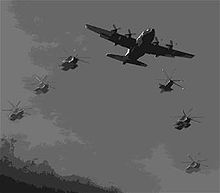 Son Tay Raiders - 1970
Son Tay Raiders - 1970
NKP was one of the staging bases for the failed Son Tay POW rescue mission in November 1970. Its objective was the rescue of approximately 90 American Prisoners of War from the prison camp. While the attempted rescue itself was a failure (the prisoners had been moved some months before, and none were found at the targeted POW compound in North Vietnam), the successful demonstration of capability in Operations Ivory Coast and Kingpin was in part responsible for the creation of a joint United States Special Operations Command in 1987.
Beginning of the End
By 1971 North Vietnamese forces were fighting conventional battles in Laos as mobile, regular battalions rather than insurgent guerrilla units. The US pulled out of Laos in 1973 as part of an overall peace and disengagement plan. North Vietnam ignored the agreement and retained its army in Laos. The national government was forced to accept the Pathet Lao into the government.[4]
In 1975, North Vietnamese and Pathet Lao forces began attacking government strongholds. A deal was eventually brokered that gave power to the Pathet Lao to save the government from total destruction. Pathet Lao troops marched into Vientiane on 1 May and simply took over the government.
Palace Lightning - USAF Withdrawal
With the collapse in Laos and the fall of both Cambodia and South Vietnam in the spring of 1975, the political climate between Washington and Bangkok began to sour, and the Thai Government demanded that the U.S. remove the bulk of its forces out of Thailand by the end of the year. Under operation Palace Lightning, the USAF began to withdraw its aircraft and personnel from Thailand. On 30 June 1975 the 56th Special Operations Wing was deactivated in place and the 656th Special Operations Wing was activated as a placeholder unit at NKP until the USAF could complete its withdrawal. The Search and Rescue units were among the last to leave the country. The 3rd Air Rescue and Recovery Group lowered its flag on 31 January 1976 and NKP was turned over to the Thai government.
Major USAF Units at Nakhon Phanom Royal Thai Air Force Base
- 56th Special Operations Wing
- 56th Combat Support Group
- 1st Special Operations Squadron
- 18th Special Operations Squadron
- 21st Special Operations Squadron
- 23d Tactical Air Support Squadron
- 37th Aerospace Rescue and Recovery Squadron (Detachment)
- 38th Aerospace Rescue and Recovery Squadron (Detachment)
- 40th Aerospace Rescue and Recovery Squadron (Detachment)
- 361st TEWS
- 456th Munitions Maintenance Squadron
- 554th Reconnaissance Squadron
- 1987th Communications Squadron
- 6994th Security Squadron
- 6908th Security Squadron
- Task Force Alpha
- 6 Aerial Port Squadron (MAC) (Detachment)
- 621st Tactical Control Squadron (Detachment)
- Red Horse Squadron, Civil Engineering squadron
Major USAF Aircraft Assigned to NKP
- Douglas A-1E/G/H/J Skyraider
- Douglas A-26A Invader
- Fairchild AC-119K
- Douglas C-47/EC-47 Skytrain
- Sikorsky CH-3E Sea King
- Sikorsky HH-53 Super Jolly Green Giant
- Fairchild AC-123K Provider
- North American T-28 Trojan
- Cessna O-1 Bird Dog
- Cessna O-2 Skymaster
- North American OV-10 Bronco
Additional "civilian" aircraft operated from NKP were the Cessna 185, Cessna Skymaster, Pilatus PC-6, Helio Courier, de Havilland DHC-4 and Douglas DC-3.
Accidents and incidents
- On 21 November 1972, Douglas EC-47Q 43-49771 of the United States Air Force crashed killing two of the 10 people on board.[5] The aircraft was operated by the 361st Tactical Electronic Warfare Squadron, United States Air Force. It had flown a tactical mission under the callsign "Baron 56", and had taken off at about 10:44 local time (03:44 UTC). At 17:00, the aircraft was returning from the mission when it bounced on landing and started to depart the left side of the runway. The pilot over-corrected, causing the aircraft to depart to the right of the runway. Although a go-around was initiated, the aircraft impacted trees damaging the port propellor. The co-pilot considered that the starboard engine was failing and that engine's propellor was feathered. The aircraft then crashed into another bank of trees 2 nautical miles (3.7 km) beyond the end of the runway. The wrecked aircraft was consumed in the post-crash fire.[6]
The Mayaguez Incident On May 13, 1975 General Burns and his Seventh Air Force staff developed a contingency plan to retake the Mayaguez using an assault force composed of men of the 656th Air Force Security Squadron, Nakhon Phanom. 75 volunteers from the 656th would be dropped onto the containers on the decks of the Mayaguez on the morning of 14 May. In preparation for this assault 5 HH-53s and 7 CH-53s were ordered to proceed to U-Tapao Royal Thai Navy Airfield for staging[30]. At approximately 21:30, one of the 21st SOS CH-53s (68-10933, call sign Knife 13) crashed, killing 18 security police and the five man crew.
See also
- United States Air Force In Thailand
- United States Pacific Air Forces
- United States Special Operations Command
- Air Force Special Operations Command
- Seventh Air Force
- Thirteenth Air Force
References
- ^ Thailand.http://en.wikipedia.org/wiki/Communist_Party_of_Thailand
- ^ First Hand Account(November 1962)by Assistant Alpha Company Commander Ltjg. George W. Fowler (with pictures) http://aircommandoman.tripod.com/id26.html
- ^ a b ://www.tlc-brotherhood.org/bases.htm
- ^ See generally William J. Duiker, The Communist Road to Power in Vietnam (1981). See also Henry A. Kissinger, Years of Upheaval(1982); Henry A. Kissinger, Years of Renewal (1999).
- ^ "43-49771 Accident description". Aviation Safety Network. http://aviation-safety.net/database/record.php?id=19721121-1. Retrieved 7 September 2010.
- ^ "EC-47 43-49771 Crashed on Takeoff November 21, 1972". EC-47. http://www.ec47.com/nov2172.htm. Retrieved 9 September 2010.
Other sources
 This article incorporates public domain material from websites or documents of the Air Force Historical Research Agency.
This article incorporates public domain material from websites or documents of the Air Force Historical Research Agency.- Endicott, Judy G. (1999) Active Air Force wings as of 1 October 1995; USAF active flying, space, and missile squadrons as of 1 October 1995. Maxwell AFB, Alabama: Office of Air Force History. CD-ROM.
- Glasser, Jeffrey D. (1998). The Secret Vietnam War: The United States Air Force in Thailand, 1961-1975. McFarland & Company. ISBN 0786400846.
- Martin, Patrick (1994). Tail Code: The Complete History of USAF Tactical Aircraft Tail Code Markings. Schiffer Military Aviation History. ISBN 0887405134.
- Ravenstein, Charles A. (1984). Air Force Combat Wings Lineage and Honors Histories 1947-1977. Maxwell AFB, Alabama: Office of Air Force History. ISBN 0912799129.
- Robbins, Christopher (1985) Air America. Avon, ISBN 0380899094
- Robbins, Christopher (1987) The Ravens: Pilots of the Secret War in Laos. Crown, ISBN 0517566125
- Warner, Roger (1998) Shooting at the Moon: The Story of America's Clandestine War in Laos. Steerforth, ISBN 1883642361
- Airport information for VTUW at World Aero Data. Data current as of October 2006.
External links
Air Bases 
Wings Commands 
South Vietnam  BasesWings
BasesWingsThailand  BasesWings
BasesWingsOther major
support facilitiesBasesClark (Philippines) · Ching Chuan Kang (Republic of China) · Andersen (Guam) · Kadena (Japan) · Misawa (Japan)Categories:- Closed facilities of the United States Air Force
- United States military bases of the Vietnam War
- Royal Thai Air Force bases
- Royal Thai Air Force
- Mekong River
- Nakhon Phanom Province
- Isan
Wikimedia Foundation. 2010.



